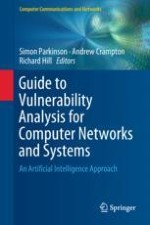
2018 | OriginalPaper | Chapter
Review into State of the Art of Vulnerability Assessment using Artificial Intelligence
Authors : Saad Khan, Simon Parkinson
Published in: Guide to Vulnerability Analysis for Computer Networks and Systems
Publisher: Springer International Publishing
Activate our intelligent search to find suitable subject content or patents.
Select sections of text to find matching patents with Artificial Intelligence. powered by
Select sections of text to find additional relevant content using AI-assisted search. powered by